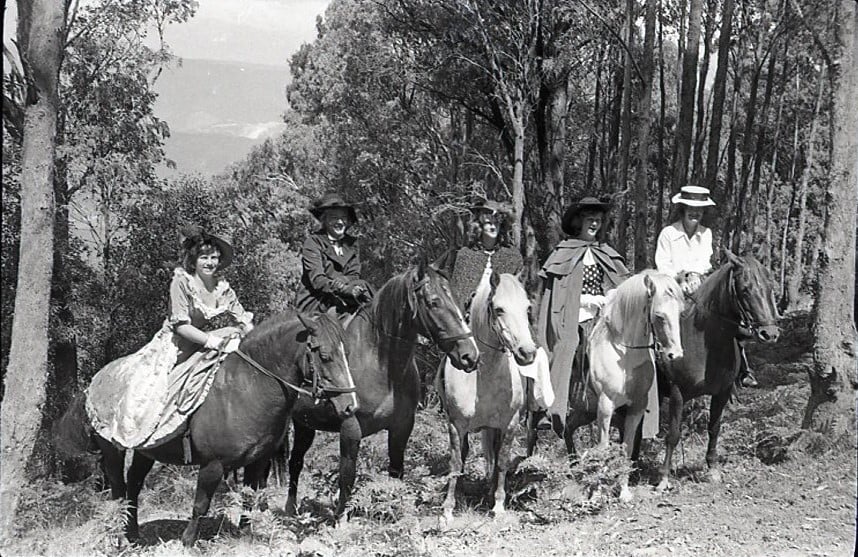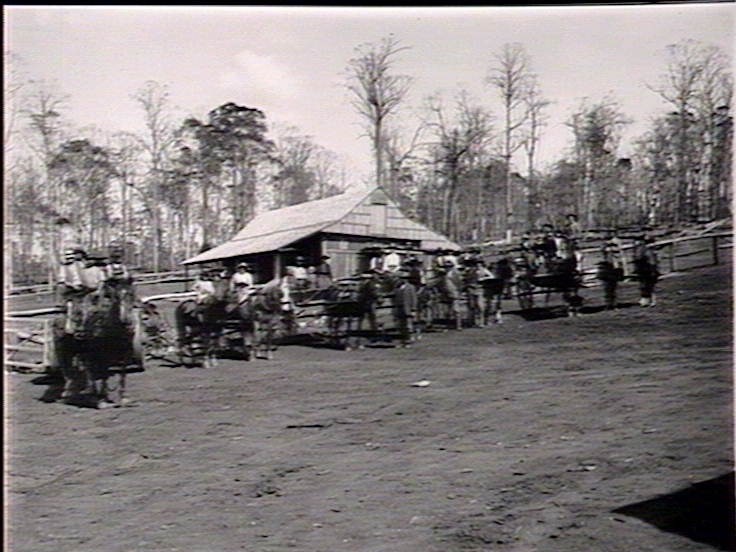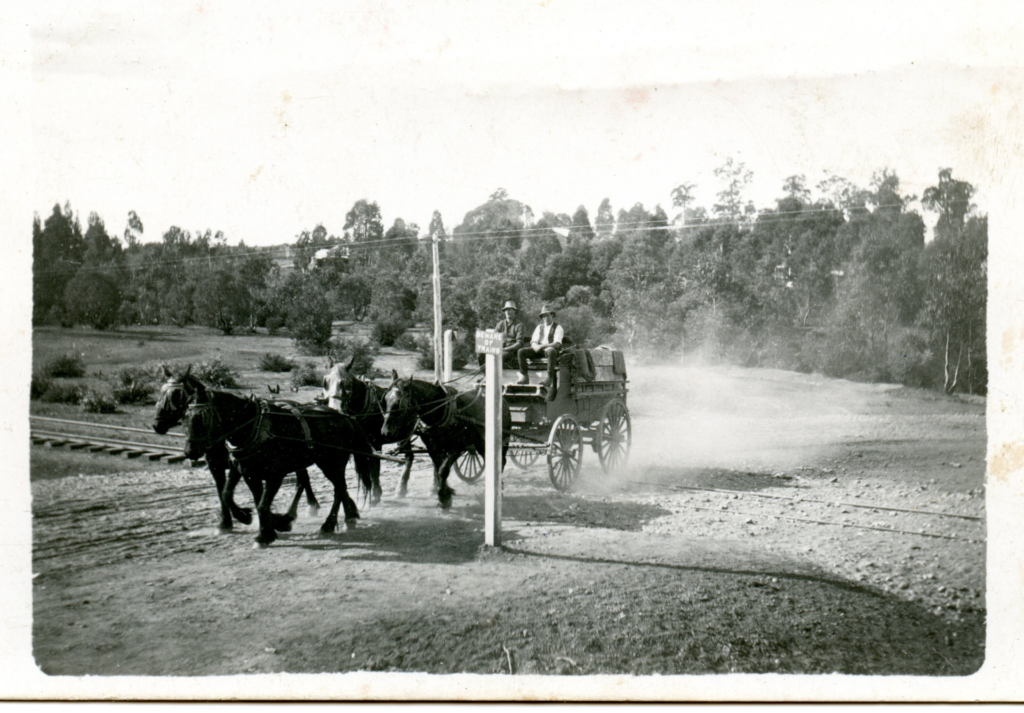Bago State Forest

© Janet Lane, 2024. Image: NSW Government Gazette, 23rd April 1872
The Wiradjuri, Wolgalu & Ngarigo peoples were the first in the Bago area and remain custodians. The Bago State Forest is adjacent to the Kosciuszko National Park in the Snowy Mountains, incorporating native ash on the Bago Plateau, early 1900s arboretum plantings, and plantations of largely sugar pine (pinus lambertiana).

Article from Tumut & Adelong Times, 11th December 1934
This newspaper article shows that horses were wild in the forest in those times; of a good nature, and ideal sorts for heavy work.
The 1872 article feature image for this post provides a good example of how many horses ran free on the big stations right from early settlement times: with no boundary fences many lived in state forest.
Hardly any photographs of the horses can be found in archival searches, possibly due to the remoteness of the area mostly settled by soldier settlers, not a lot of call for cameras or journalists!
Some of the big stations set up in the 1830’s and 40’s in the greater Bago area were Maragle stn, Bago stn, Mannus stn, Wetere stn, Osburne’s stn, Murray stn and Tooma (Tuma) stn, all marked by Paul Strzlecki on his journey through there in 1840. By 1854 Maragle had grown to 49,000 acres.
In the 1920’s pastoral leases were still being taken up in the area, of 100 to 1,600 acres; there was an interesting condition to these grazing leases that all invasive weeds (identified) were to be removed and no fencing could be done without permission from the mines dept. So one can see how many horses came to be free roaming as fences were restricted for mining access.
From the 1870’s and up until 1949 many smaller farms were set up, these did more intensive agriculture. The cold and the good rainfall were suited to fruit and dairy. Despite much forbidding terrain there were plenty of good flats; Horses were vital to all for transport and work.

Images of Batlow Women’s Land Army courtesy of Bev Widdison, Batlow Historical Society Facebook group. Content from AWM.
The Australian Women’s Land Army was formed during the Second World War (July 1942) to help with labour supply shortages in the agricultural sector. There were full-time members who worked a 48 hour week on average, and auxiliary members who had to be available for not less than a month at nominated seasonal times of the year.
The AWLA was wound up at the end of 1945.
Recruits had to be between 18 and 50 years of age and be British subjects or immigrants from Allied nations. Women on the land who were farmers, employees or relatives of land holders were not eligible to enlist. AWLA women were generally drawn from city areas and were often unskilled in rural work. This new form of labour had to be heavily promoted to rural employees, who were initially resistant to female labour. Sceptical attitudes, however, generally changed to praise and respect.
In October 1942 the Minister for Labour and National Service, aware of the need to compete with the three women’s services, recommended improving the status of the AWLA by instituting it as a fourth service. In January 1943 Cabinet endorsed the status of both divisions of the AWLA as an “official fourth service”.


Forestry became an industry early on (especially a bit further west in the Barmah-Millewa forest) – powerful horses used. In 1884 a published list of land selections granted from Albury showed runs of 100 acres to 200 acres being taken up – interestingly, several by women – in the greater area. One selection was over 600 acres. Mining leases were also published, ranging from 1 to 20 acres – a miner had room to scratch for gold and to keep work horses.
Early in the 20th century, about 1911, the government set up a Settlement scheme at Bago, similar to the Soldier Settlement schemes, which were also done in the area. Land was offered at very low rates with little or no deposit, of a size sufficient for a small farm – the first 10 acres where a homestead could be built, was cleared by the government. Small to medium acreages (40 to 120 acres mostly) were taken up. Many blocks also sold off in the Maragle State Forest. The settlements went until 1949 but created a public outcry at times as many blocks ran into the forests and little was done to make good roads, for example the main road from Tumbarumba, hence the blocks being almost inaccessible at times – horses vital. Roads did of course improve in time. Locally bred horse teams used in road making, and later on the rail to Tumbarumba.
Nonetheless some good farms were set up and again horses were the primary workers. Many orchards went in, and dairies. News reports of many wagons taking 8 to 10 tons a load to the settlements. Strong horses and wise, as the going was terrible. Produce had to be taken out too. After 1945 many of the smaller blocks were bought back and consolidated into bigger runs.


State Library NSW images: Soldier Settler block, Batlow; Batlow Soldier Settlement: Settlers and their families

Horses from stations in the greater Bago area were droved out to the Tumbarumba sales and the Albury and Wodonga sales – at times the biggest in Australia. Many went overseas and some to WW1.
Timber harvesting was allowed in the State Forest on a permit basis with royalties paid. The state itself ran mills. Private timber mills went up. Timber was used locally, and taken out – very popular in Sydney for house building and furniture making, being high quality species suited for these purposes such as mountain ash (euc) and coachwood. Plantations of pine species were put in to supply the Sydney market and local needs. Horses were vital for getting timber out.
In 1936 eight men worked full time at the Bago State Forest timber mill, it was 18 miles from Batlow in snow country. They had just gone from horses to machinery.
Batlow had gone from gold mining to Soldier Settlements, which made a flourishing community with a tree nursery, three timber mills, school, stores and many industrious small farms – many being orchards. Cherries and apples from the area were famous. Some started out growing big vegetable crops. The mills made timber into fruit packing cases, for this reason pines were propagated and raised; plane trees were also propagated at the nursery, being planted in rows on some stations for firebreaks.
Batlow farmers bred good utility horses. Some were taken to the Sydney Easter show.
Due to beautiful scenery, it became a tourist mecca early. Waterfalls, rivers, rocky outcrops. Locals also loved to ride to scenic places in the Bago area. It was very heavy going for the mill horses for many years, creeks to be crossed, boggy areas, steep areas. A later tramway in some parts helped the horses a lot. Even later rail went through to some places.
By 1858 gold mining was established on Maragle station, quickly spread to other stations, being primarily carried out on waterways. Miners too relied on horses. It was successful early on, and flourished in the 1870’s but by the late 1890’s had petered out. The miners relied on horses to get in and out, and to get their supplies in.
So horses of the area were working horses, many used for timber harvesting. Many for farming. Good strong powerful horses, and very sure footed, having been born and raised in the ranges. From earliest times there, 1830’s, they were run in unfenced runs and over the years of course some became wild. In some places work horses were turned out when a place became mechanised and allowed to live out their days in back runs and the forest.


Image from: theaustralianalpsnationalparks.org
It’s yet another tragedy the government goes on shooting to wipe out these beautiful, good horses with a great legacy, instead of finding homes for the old-fashioned horses amongst them, or allowing a managed population to exist there, keeping fire hazard down and providing safe walkways for wildlife (conservation grazing). Indeed, terrible bushfires in 2020 wiped out most of the area. Parks and traditional uses co-existing: as happens on Snake Island for example.
Their bloodlines would go back to some of the earliest horses brought to Australia, they are wise, good natured, strong, safe horses.
Check out the horses from Bago and KNP recorded in our database here.
References and suggested reading
The Junction of Maragle Back Creek and Reedy Creek, Maragle European Context and Land Use History by Dirk H.R. Spennemann for the Institute of Land, Water and Society at Charles Sturt University, 2016. https://researchoutput.csu.edu.au/ws/portalfiles/portal/20164601/19594811_report.pdf
Trove (Australian archives), newspapers.